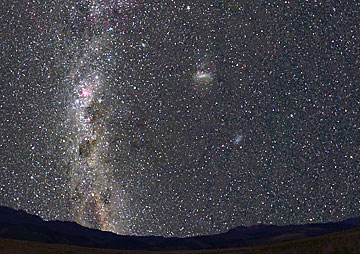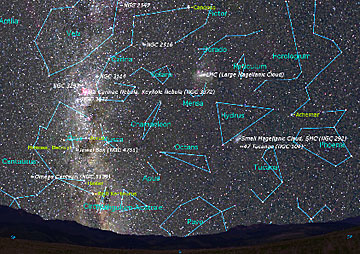
I've just returned from a month's vacation in New Zealand and Australia. The astronomical highlight was four nights spent under pristine skies at the Deepest South Texas Star Party. This event, sponsored by the Three Rivers Foundation in Texas, took place at Warrumbungle Mountain Motel, about half way between Siding Springs Observatory and the town of Coonabarabran, in New South Wales, Australia.
 Map courtesy Google Maps
Map courtesy Google Maps
This was a rather different star party than we are used to in North America. Because of the travel involved for most of us, scopes were provided by the Three Rivers Foundation at the site, including several large Obsession Dobsonians, 18-inch and 25-inch aperture, equipped with Argo Navis digital setting circles and ServoCat goto systems.
The observing field was directly adjacent to the motel, which served as a giant warm-up hut. Closely mowed grass made navigating the field in the dark very easy. Below is the 18-inch f/4.5 Obsession I used for most of my observations, with a couple of 25-inch Obsessions lurking in the background.

Naturally, for this expedition into uncharted celestial territory, I turned to Starry NightŪ for guidance. Needless to say, despite the comprehensiveness of Starry NightŪ's database of observing locations, Warrumbungle was not included, so I had to enter its longitude and latitude manually: 149° 11" 22' E and 31° 16" 24' S.
As soon as it got dark on my first night at Warrumbungle, March 2/3, I cast my eyes south and saw this spectacular vista, here recreated in Starry NightŪ Pro Plus:

Not much here that I recognized, despite decades of observing northern skies! From a couple of trips south before my serious observing days, I could spot Alpha and Beta Centauri low in the southeast, with the Southern Cross and the Coal Sack just above them, but that was about it. However, Starry Night soon provided me with a wealth of information:

Most of the southern constellations are forgettable, with the exception of the great star groupings along the southern Milky Way, especially Centaurus, Crux, and Carina. There are few bright stars outside these three, notably Canopus, high overhead, and Achernar at the southern terminus of the great river Eridanus, which can be traced all the way north to Orion.
What are absolutely outstanding are the three great galaxies: our own Milky Way, much brighter in Carina than anywhere visible from the northern hemisphere, and our two satellite galaxies, the Large and Small Magellanic Clouds. As their name implies, the latter two look exactly like small patches of cloud in the dark sky.
As I began my explorations with naked eye and 10x50 binoculars, I concentrated on the Milky Way. Focusing on Crux, I immediately spotted the Coal Sack, the inky dark nebula just below it, with the brilliant Jewel Box star cluster right beside it. With the help of my Aussie friend John Bambury, manning the Obsession 18-inch, I was introduced to the three finest objects in the southern sky.
- The first was the great globular cluster Omega Centauri, which some say is the remains of a dwarf galaxy swept clean by a distant encounter with our Milky Way. I had observed Omega Centauri a few years ago with 15x70 binoculars from Bermuda, but now it was high in the sky and its hundreds of thousands of stars filled the telescope's field of view.
- Next came the most beautiful globular cluster of them all, 47 Tucanae. It appeared very different in the telescope from Omega Centauri: it has an incredible concentration of stars at its centre, fully resolved in the 18-inch, tapering off towards the edge of the field of view, in contrast to Omega Centauri's more even distribution of stars.
- Finally there was Eta Carinae and its surrounding nebulosity: the strikingly yellow Homunculus Nebula at the centre, where a supernova is preparing to burst forth, the dark Keyhole Nebula near by, and finally the vast brilliant emission nebulae enclosing these central objects.
This was just the first of four perfect nights. One entire evening was spent exploring star clusters and nebulae within the confines of the Large Magellanic Cloud: a whole galaxy of objects for the picking, culminating in the gigantic Tarantula Nebula. Another night we explored the galaxies and galaxy clusters normally hidden well below my southern horizon.
We even observed some "northern" objects. The galaxy Messier 83, which is one of the most difficult Messiers from northern latitudes, usually giving only a glimpse of its small nucleus through the horizon haze, was revealed as a gigantic pinwheel. And I finally managed to see the Horsehead Nebula, with the help of a Hydrogen Beta filter in the 18-inch Obsession.
One morning I rose just before dawn to observe the juxtaposition of our "summer" Milky Way in Sagittarius with the "winter" Milky Way of the southern hemisphere, finally managing to visualize the whole of the celestial sphere, north and south.
April 2008
Geoff has been a life-long telescope addict, and is active in many areas of visual observation; he is a moderator of the Yahoo "Talking Telescopes" group.















